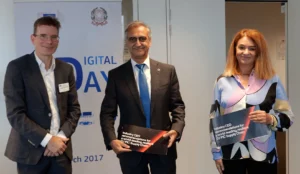Insider Brief
- European photonics CEOs present an eight-year €4.25 billion investment plan to bolster photonics innovation and production in Europe.
- Europe faces a precarious position in the global market for photonic integrated circuits, according to the executives.
- The CEOs argue that bolstering Europe’s PIC supply chain is not just about economic benefits but also strategic autonomy.
The CEOs of eight leading European integrated photonics companies have laid out an ambitious multi-billion euro strategy to the European Commission’s top technology officials, aiming to revolutionize the European photonic integrated circuit (PIC) industry, according to Reuters and other media reports.
The proposal, which seeks a substantial €4.25 billion investment over the next eight years, was presented to key figures including Dr. Thomas Skordas, Deputy Director-General, DG Connect, Lucilla Sioli, Director for Artificial Intelligence and Digital Industry, and Werner Steinhögl, Head of Sector for Microelectronics & Photonics.
This strategic plan is a response to Europe’s current precarious position in the global PIC market. With less than 6% of the continent’s manufacturing capacity dedicated to indium phosphide and silicon nitride PICs, and a slim 4% share in the global assembly, testing, and packaging operations, Europe is at a significant disadvantage. The reliance on non-EU sources, particularly from Asia, is seen as a vulnerability to the EU’s economic sovereignty and security.

 The CEOs argue that bolstering Europe’s PIC supply chain is not just about economic benefits but also strategic autonomy. The PhotonDelta consortium from the Netherlands highlighted concerns about rival countries’ attempts to acquire European PIC technologies. There is an increasing push to influence small and medium-sized enterprises (SMEs) within the EU PIC supply chain, which further underscores the urgency of the proposed investment.
The CEOs argue that bolstering Europe’s PIC supply chain is not just about economic benefits but also strategic autonomy. The PhotonDelta consortium from the Netherlands highlighted concerns about rival countries’ attempts to acquire European PIC technologies. There is an increasing push to influence small and medium-sized enterprises (SMEs) within the EU PIC supply chain, which further underscores the urgency of the proposed investment.
The proposed financial infusion aims to develop a robust and resilient PIC supply chain that could independently meet the needs of EU customers. This move is expected to mitigate risks associated with external dependencies and reinforce the EU’s position as a significant player in the global photonics sector.
This bold strategy represents a pivotal point for the European Commission, which now faces the critical decision of whether to back the investment. Doing so could potentially place Europe at the forefront of the photonics industry, ensuring technological sovereignty and securing its economic future in the increasingly competitive global market.
The strategy includes the following recommendations, according to EENewsEurope:
- Provide over €2 billion in incentives for industrial scale InP and SiN photonic IC manufacturing capacity.
- Provide EU SMEs access to industrial photonic test and experimentation facilities similar to commercial lines, with the latest commercial wafer processing equipment and tools, at the relevant industry standard wafer sizes.
- Establish an industrial photonic IC ‘manufacturing supply chain’ resilience fund of €200 million to support the investments needed to strengthen linkages and minimize vulnerabilities.
- Provide a €360 million fund to stimulate application development through offering design tape-outs, leading to industrial photonic design IP creation and validation based on hardware testing.
- Promote and incentivise collaboration amongst vertical clusters and the European photonic IC ecosystem.
Johan Feenstra, CEO of SMART Photonics, said in a statement: “Over the past few years we have been repeatedly reminded that the world is becoming a more volatile and unpredictable place. Global supply chains have been shown to be fragile, and overreliance on one country for critical components is an economic and security risk. This is particularly true of the semiconductor industry.”
“Photonic integrated circuits have the capacity to transform a huge range of industries. It is also fundamental to the advancement of some of the most exciting new technologies. Currently, the EU has a vibrant and growing integrated photonics industry, however, without volume manufacturing, testing and packaging capacity we are incredibly vulnerable to global events and the policies of competitor countries.”
“Our proposal outlines a number of practical steps that the EU can take over the next decade to ensure the continued growth and security of the integrated photonics industry. For just over €4 billion we can build our supply chain and ensure the future of an industry which has the capacity to generate hundreds of billions of Euros each year for decades to come.”
Members of the group are:
- Rudi de Winter – CEO of XFAB
- Johan Feenstra – CEO of SMART Photonics
- Felix Grawert – CEO of Aixtron
- Albert Hasper – CEO of PHIX Photonics Assembly
- Inigo Artundo – CEO of VLC Photonics
- Jean-Louis Gentner – CEO of Almae
- Thomas Hessler – CEO of Ligentec
- Ewit Roos – CEO of PhotonDelta
If you found this article to be informative, you can explore more current quantum news here, exclusives, interviews, and podcasts.

















